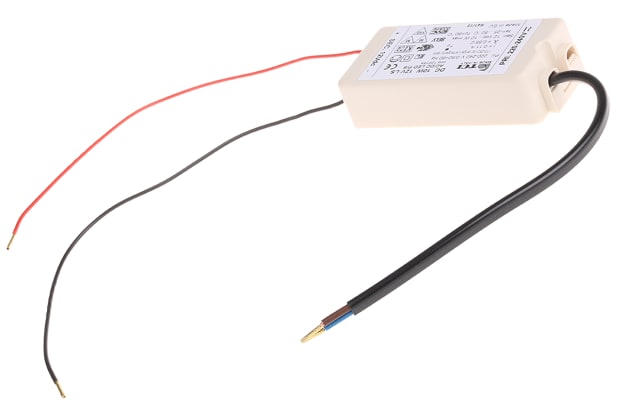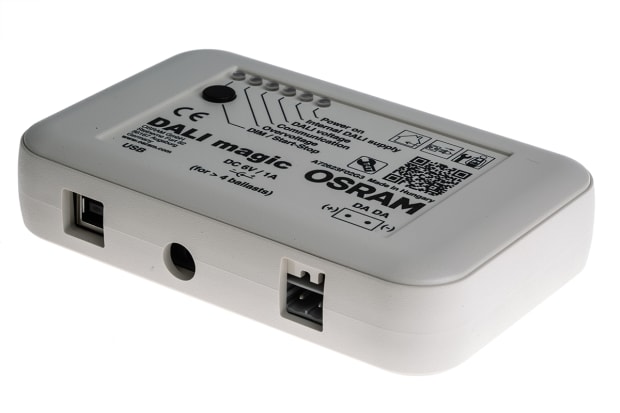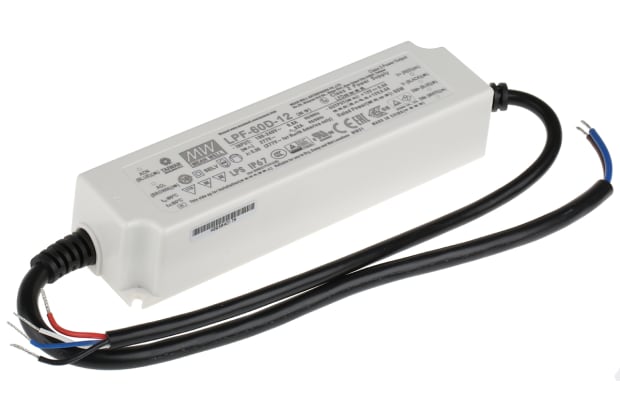- Published 24 Jan 2023
- Last Modified 29 Aug 2023
- 12 min
A Complete Guide to LED Drivers
Our LED drivers guide explains what they are used for, how they work, the key features and types & how to use them.

Reviewed by Jay Proctor, Technical Support Team Leader (October 2021)
What is an LED Driver?
LED drivers are specialist power conversion devices used with LED equipment. What is an LED? A light-emitting diode is a small component made from an electrically conductive material. These emit light of different colours when current passes through, triggering the release of light particles called photons.
LED technology was first developed in the 1960s and is now deployed in a wide variety of lighting equipment, including:
- Domestic and retail settings - e.g. light strips and downlights
- Camera flashes
- Monitors and televisions
- Vehicle lights such as headlamps, taillights and brake lights
- Traffic signals
- Aeroplane lighting
- Commercial mood lighting in hotels, restaurants, and other hospitality venues
- Outdoor and underwater lighting systems
LEDs are noted for their energy efficiency, environmental friendliness, and long lifespans.
LED Drivers Explained
LEDs require a reliable power supply to operate. Drivers for LED lights supply this power, converting alternating current (AC) to direct current (DC). They ensure the power supply is constant and uninterrupted by compensating for changes in the temperature and electrical conductivity of the LEDs. This prevents overheating, flickering, colour changes and degraded performance.
LED drivers for lighting also offer thermal shutdown protection - this will switch off lighting altogether if the temperature climbs too high.
Most LED equipment is low Voltage. LED transformers perform the same function for larger lighting systems that require more power.
Alternative names for LED drivers include:
- LED power supplies
- LED light drivers
- LED driver circuits

Do All LED Lights Need a Driver?
Yes, all LED lights do require a bulb driver to operate but it is not always necessary to purchase these separately. Some models are supplied with an integrated driver - in particular, standard LED bulbs designed for use in domestic settings.
Lower voltage LEDs do normally require a separate driver, but this has one advantage. If the driver breaks, it can be replaced without having to replace the bulb too.
What is an LED Driver Used for?
What does an LED driver do? LED drivers have a similar function to transformers for low voltage bulbs. LED lights are primarily low Voltage devices - typically 4v, 12v or 24v - and are designed for a direct current power supply. However, most wall socket power supplies are not directly compatible as these usually run at a much higher Voltage (between 120 and 277V) and supply alternating current. As the average Voltage of an LED is too low for a conventional transformer, specialist LED drivers are used to convert high voltage alternating current to low voltage direct current.
LED drivers have the secondary function of preventing power surges and fluctuations, which can cause high temperatures and affect light output. LEDs are designed for use within a strict predetermined amp range.
Some LED drivers can also be used to control and sequence the brightness of the LED systems attached and the colours which are displayed. This is done by selectively switching individual LEDs on and off. White lights, for example, are usually created by displaying LEDs of multiple colours at once - switch some of these off via the LED and the white colour is no longer visible.
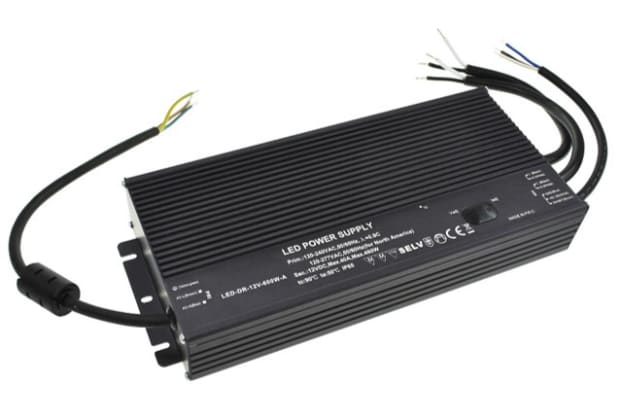
How Do LED Drivers Work?
How does an LED driver work? Simply put, the forward Voltage requirements of an LED will vary as its temperature changes. As it becomes hotter the amount of Voltage needed to pull current into the LED will drop and it will therefore draw in more power. Left unchecked, the temperature would continue to climb, and the LED would burn out - a process known as thermal runaway. LED drivers feature power output levels that match LED requirements. The steady current supplied by the driver prevents thermal runaway by responding to changes in the forward Voltage.
Constant Current vs Constant Voltage LED Drivers
Constant current LED drivers are used with LEDs that require a steady current but varying Voltages as the wattage (total power load) in each LED changes. The driver is responsible for varying the Voltage.
The principal amperage ratings for constant current LED drivers are:
- 350 milliamps (mA)
- 700mA
- 1 amp
A typical configuration might be the supply of a 700 milliamps (ma) current as the Voltage varies between four and 13 volts in response to a 50-watt load.
These devices are also known as constant power LED drivers. Typical uses include:
- Illuminating outdoor features
- High definition displays for use in public spaces
- Backlighting for billboards
By contrast, constant Voltage LED driver circuits are designed for LEDs that need steady Voltage - typically 10V, 12V or 24V DC. This makes them best suited to LEDs arranged in a line or string - e.g. lighting strips or similar configurations parallel to the driver. Normally LED strip drivers have a separate resistor for each LED in the strip - this is known as a current limiting resistor.
Voltage Rating
LED drivers provide a bridge between mains power supply and LED lights, converting medium and high Voltage alternating current to lower Voltage direct current. It is important to ensure that the LED driver you select is rated for compatibility with the power supply you will be connecting it to. Typical mains supply Voltages include:
- 120V
- 220V
- 277V
- 480V
LED drivers typically run at 12V or 24. 5V systems are also found. A broad selection of LED driver Voltage ratings is available for both constant current and constant Voltage LED drivers. The maximum output of the LED systems should be less than the maximum Voltage for which the driver is rated.
Power Types
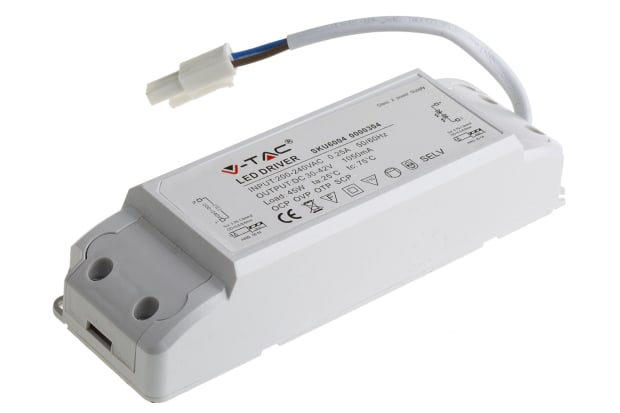
The central function of an LED driver is converting a higher-voltage alternating current (AC) to direct current (DC) running at lower Voltage - typically 12v or 24v.
DC flows in one direction only while AC changes direction at set intervals. AC is the standard form of electricity supplied over the power grids because it can be efficiently transmitted over long distances and it is easy to change the Voltage using a transformer.
LED Driver Features & Types
Like all components, LED drivers are available in a variety of models with differing specifications. Amongst other factors, available input and output levels vary between models, along with efficiency, power ratings, and the amount of environmental shielding (ingress shielding) applied to protect the connection terminals.
Let’s look at a few of the principal models available:
Small LED Drivers
Small or mini LED drivers are designed for use with smaller LED lights. A 4-watt rating would be typical.
Dimmable LED Drivers
Dimmable LED drivers allow users to dynamically adjust the brightness of LEDs. Adjustable LED drivers are a useful way to create mood lighting in public spaces such as shops.
High Power LED Drivers
The power of LEDs is growing steadily - some professional models now offer as much as 100 lumens per watt. Lumens are an internationally recognised unit of visible light. These high-power models are widely deployed in the larger lighting systems used in commercial and public spaces. Naturally, these require more powerful LED drivers or turbines to ensure smooth operation.
COB LED Drivers
Chip on board (COB) LEDs consist of multiple LEDs in a cluster alongside integrated circuitry. Typically, they include a dimming function. You will require a compatible driver or transformer with a sufficient Voltage rating. Both constant current and constant voltage drivers are compatible with COB LED drivers but constant current models are easier to apply.
LED String Driver
LED strings normally feature smaller lights. They are typically used for mood lighting effects - for example, Christmas lights. Mini LED drivers are the best choice for these, although the total Voltage requirements may climb for longer strings.
How to Use an LED Driver
LED Driver Installation Instructions
- Make sure your LED driver is fully compatible with your power supply and the LED system you intend to attach it to. The Amperage and Voltage ratings should match
- Ensure the driver will not be exposed to environmental stresses it is not rated for. For example, if you are installing LEDs in an outdoor environment, ensure your driver has a sufficient level of water resistance
- Identify the positive and negative wires in your socket, then disconnect the socket from the grid
- Install the driver - attaching this to the LED system with colour coded screws
- Connect the positive and negative wires from the LED system to the corresponding terminals on the driver
- Connect the green grounding wire (the GND) on the driver to a grounding terminal
- Connect the positive and negative wires in the power socket to the corresponding terminals on the driver
- Carefully test the installation to ensure connections are correct and firmly applied and that there is no build-up of heat. If malfunctions occur, disconnect your power supply, and identify the cause
How to Repair an LED Light Driver
- Disconnect the power
- Open the driver with a screwdriver and check carefully for visible faults and any burn marks
- Use electrical testing equipment to identify the faulty components
- Replace these components if possible and test the unit. If it is not possible to do so, the entire driver will require replacement
In the interests of safety, please ensure that the inspection and repair of the LED driver are performed by a qualified engineer.
What LED Driver Do I Need?
To decide what size LED driver you will need to meet your requirements, you will need to know:
- The Voltage of the mains power supply you will be using
- The total power consumption of the LEDs in the system
- Whether the LEDs require a steady Voltage or a steady current
- Any other technical factors that might affect the operation of the LED drivers - for example, the need for precise colour control or any potential exposure to water. Water resistance is indicated by the LED’s IP rating - higher numbers are more resistant. An IP rating of 44 would suggest suitability for use in kitchens or other rooms where periodic splashing may occur. Meanwhile, a high IP rating of 67 indicates a driver suitable for outdoor use. Drivers with an IP rating of 20 are for use in dry indoor spaces only
Another consideration is the brand or manufacturer. Popular LED driver brands include:
FAQs
How to Connect an LED Driver to Power
Although wiring an LED driver to mains power is straightforward, we would recommend that a qualified electrician inspects this to make sure the connections have been made safely.
The process of connecting an LED driver to power consists of connecting the neutral and line wires to the PRI (primary) side of the driver, attaching the former to the N terminal and the latter to the L terminal. The positive and negative wires should then be taken from the LED lighting and attached to the matching terminals on the SEC (secondary) side of the driver.
How to Wire LED Drivers and Transformers
Often, LED drivers and transformers do not include terminals, and so users must directly wire a plug to the end of the cable. Please note that wiring should only be carried out by trained and qualified individuals.
- Check the LEDs are in place and turn off the power
- Open the driver or transformer using a screwdriver
- Connect the plug using suitable cabling and wire nuts (colour-coded cabling screws). The black positive cable from the transfer should be connected to the 120V AC feed in the socket, the green cable to the grounding wire and the white negative wire to the neutral connection. It may be necessary to strip back one end of the LED cabling, depending on the brand
- Apply terminal connectors to the cabling for a firm hold
- If necessary, terminate the positive and negative wires that connect to integrated circuitry in the driver or transformer
- Close the unit and test it in a well-ventilated area
How to Test an LED Driver
There are three standard ways to test that an LED driver is functioning correctly:
- Connecting it to the LEDs and observing the results
- Using electronic load testing equipment - trying, for example, constant resistance (CR) or constant voltage (CV) modes
- Applying a load resistor (a device that impedes current) to assess the power supply
Once again, if in doubt, please do not attempt to test the component and consult a fully qualified engineer instead.
How Many LEDs Per Driver?
The total number of individual LEDs is less important than the total power they require.
To work correctly and have a reasonable lifespan, LEDs require the right amount of wattage. Too much will cause them to burn out, while too little will prevent them from working at all. But the driver components can also be stressed by power-hungry LEDs.
Therefore, drivers should ideally not be connected to LEDs that consume more than 80% of the driver’s maximum output. For example, a driver with a maximum output of 50 Watts should be attached to LEDs with a maximum collective output of 40 Watts.
What is the Difference Between an LED Driver and a Transformer?
LED transformers have a higher power output and so are used with larger LED lighting systems - for example, longer strips - which require higher Wattage levels than that provided by LED drivers to operate correctly and safely.
What is an LED Driver IC?
An LED driver integrated circuit (IC) provides the processing power necessary to allow it to respond to the changing power demands of the attached LEDs.
Do I Need a Transformer for LED Lights?
To work out whether you need a driver or a transformer, multiply the length of the system by the Watts required per metre, for example:
10 metres x 30 Watts per metre = 300 Watts
This exceeds the maximum Wattage output of an LED driver (200 Watts), so a transformer will be required. The collective power requirement of an LED system should be less than the transformer’s maximum capacity.
Can LEDs Work on AC?
Sometimes. Most LEDs are built to run on low power direct current (DC) but some high capacity models have been developed which do run on alternating current (AC).
